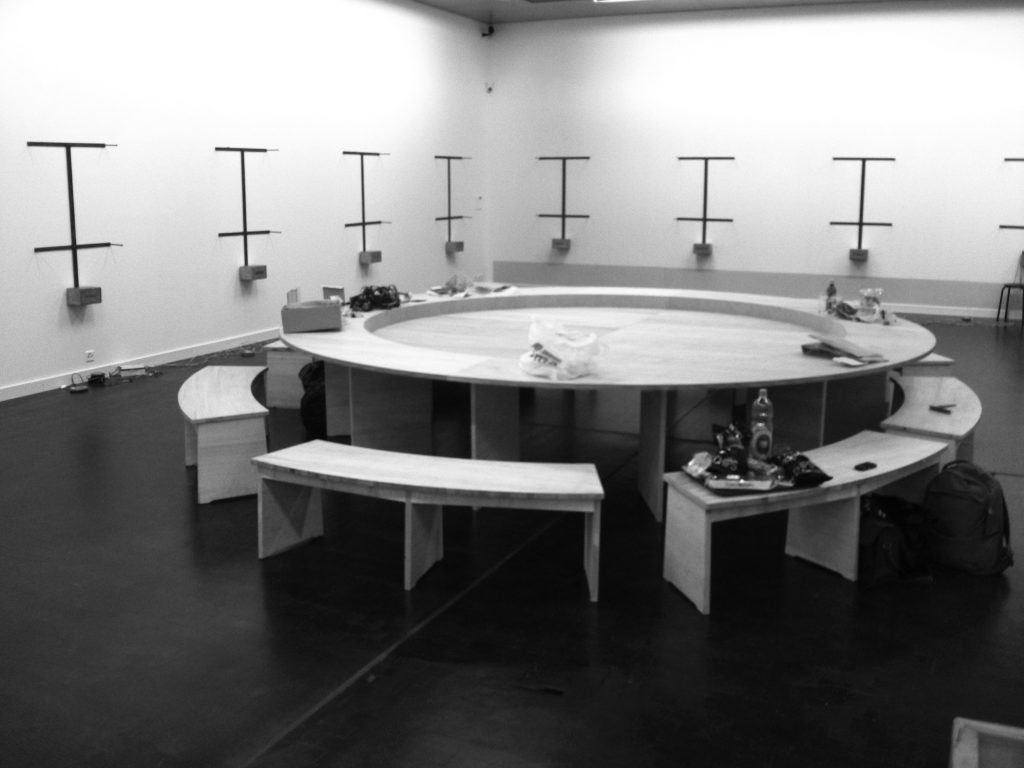COMPONENTS OF THE PROJECT
a. 20 sheets of skin, suspended on metal frames on the walls. 19 CD players with headphones are in each of the numbered metal boxes beneath each skin. [One skin has no recording. I did not find the farmer].
b. 5-meter round table, with recess to contain 10000 loose banana skins
c. 8 curved benches fit round the table. 24 people can sit, closely, but comfortably, at the table. [With children/young people up to 30. With a second row of people –one can have a ‘conference’ style exchange of approx. 100 people. See photos from 2007].
d. A ‘connective practice’/social sculpture process is designed for use at the table [See details below], and accompanying printed handbook. The installation can be experienced casually by individuals and by groups. Museum visitors do not have engage in the structured process.
Note: There should be no visual or other secondary information about the growers available, particularly in or near the installation space. Such ‘documentary’ material takes people out of the experience into a different headspace. The experience derives partly from the absence of the growers, apart from through their ‘number’, their ‘skin’ and their voices.
Other material including: contextualising information by curator/s e.g. about ‘free trade’ /slavery / colonialism; extracts from ‘the story of the project’; notes about ‘social sculpture’ [its history, the contemporary field of social sculpture and ‘connective practice’]; explanations about ways of participating in the process; and the invitation to participate in a structured, sign-up process, should be outside the space.
SPACE REQUIRED
A square space is best.
It works well in a square space of 9 x 9 meters, but this can vary, from between 12 meters square to 20 meters square. Between 12 meters square and 15 meters square is best.
Alternatively, it can be a rectangle. The two shorter sides need to be minimum 9 meters and the longer ones up to 11 meters long.
Exchange Values must have 4 walls, creating a semi-enclosed space. So sometimes a temporary wall needs to be built.
Minimum height of walls: approx 3 metres.
Other points about the space
A semi-enclosed space is best. The 4-walled space needs to have as few entrances and exits as possible. However, with the round table, and the loose, unnumbered skins in the recess in the table, if there is more than one entrance/exit, this is now less critical.
The walls need to be clear. That means – no heaters, handrails, architectural ‘furniture’, minimal visual information, preferably not wallpaper. White is best. Grey or concrete also works.
Floor material is not an issue. But it should be plain, neutral. Not brightly coloured or patterned.
5 power-points in or near space, to plug in 5 small transformers [220 volts].
TRANSPORTATION
Transportation from UK or mainland Europe [presently in Germany] and back to UK to mainland Europe, needs to be covered by the venue.
There are 5 wooden crates, the large 5 meter table and 8 benches. The table splits into two halves. Each half is 5 m x 2.5 m and about 20 cms deep. The ‘legs’ are separate. The table and crates fit in a large van that can be driven with a motor-car licence.
Two people are needed to lift the crates.
One crate contains the 20 sheets of skins. This crate cannot be in high temperatures [e.g lying at the docks in a hot country], as the skins are backed with pitch and beeswax, and will melt.
One crate contains the 10000 loose skins.
All the skins were fumigated at the last venue, but might need to be checked and fumigated again.
If transported to countries outside the EU, permits for the skins will probably need to be obtained. This has been done before.
CRATES – DIMENSIONS, WEIGHT AND CONTENTS
Crate 1 and 2
2 x 2 metre x 20cms x 25 cms
Approx weight: each long crate 35 kg
Contents: 10 folding metal frames in each crate
Crate 3
1 x 180cms x 60cmc x 50cms
Approx weight: 20 kgs
Contents: black plastic bags filled with dried and cured banana skins
(they have been round the world several times..
with no problems; no different to transporting basketwork)
Crate 4
1 x 60 cms x 80 cms x 50 cms
Approx weight: 35 kgs
Contents: 20 audio cd players, wiring, electrical equipment, 20 metal boxes, metal bolts
Crate 5
1 x flat crate containing 20 stitched ‘pictures’ made of dried banana skin covered in wax.
(These pictures or ‘sheets of skin’ must not be in places that are too hot, because the wax will melt. They are wrapped in plastic and tissue paper in the crate. They are very delicate)
